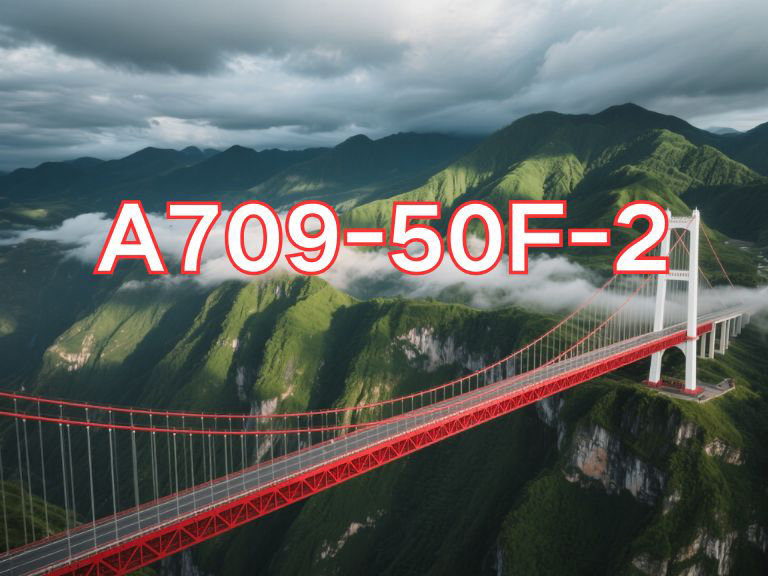

Q370q
Q370q is a high-strength low-alloy structural steel specified in GB/T 714-2015 for bridge applications, with a minimum yield strength of 370 MPa. It offers excellent weldability, toughness, and fatigue resistance, making it widely used in medium to large-span steel bridges under various environmental conditions.
Grade Designation Explanation
Q: Stands for "Yield Strength" (Qu Fu) in Chinese pinyin;
370: Indicates the specified minimum yield strength of 370 MPa;
q: Stands for Qiao, meaning "Bridge" in Chinese, indicating this grade is specifically designed for bridge structures.
Physical Properties
Density: ~7.85 g/cm³
Elastic Modulus: ~206 GPa
Thermal Expansion Coefficient: ~12×10⁻⁶/°C (20–300°C)
Thermal Conductivity: ~40–50 W/(m·K)
Yield Strength (ReL): ≥370 MPa
Tensile Strength (Rm): 510–650 MPa
Elongation (A₅₀mm): ≥20%
Impact Toughness: KV₂ ≥47 J at –20°C (Grade D), or ≥47 J at –40°C (Grade E, depending on specification)
Chemical Composition (Typical, wt%)
Element Content Range (%)
C ≤0.18
Si 0.20–0.60
Mn 1.00–1.60
P ≤0.025
S ≤0.015
Nb 0.01–0.05
V 0.02–0.10
Ti 0.01–0.05
Alt ≥0.020
Note: Microalloyed with Nb, V, and Ti for grain refinement and precipitation strengthening. Typically produced via controlled rolling (TMCP).
Application Areas
Q370q is widely used in critical components of modern steel bridges, including:
Main girders and trusses of medium and large-span bridges;
Steel arches and cable-stayed bridge structures;
Orthotropic steel decks;
Bridge components in cold regions (when supplied with Grade E quality);
Seismic-resistant bridge systems requiring balanced strength and ductility.
Testing and Manufacturing Methods
Manufacturing Process: Produced via oxygen converter or electric arc furnace melting, followed by ladle refining (LF), vacuum degassing (VD/RH), continuous casting, and Thermo-Mechanical Control Process (TMCP).
Heat Treatment: Usually as-rolled or normalized; not typically quenched and tempered due to its moderate strength level.
Testing Requirements:
- Tensile test (transverse sampling)
- Bend test
- Charpy V-notch impact test at –20°C or –40°C
- Z-direction tensile test (for thickness >20 mm)
- Ultrasonic testing (UT) per GB/T 2970 or equivalent standards
- Weldability evaluation and heat-affected zone (HAZ) analysis
- Applicable Standard: GB/T 714-2015 "Structural Steels for Bridges"
Equivalent or Similar Grades
China - GB: Q370q
USA - ASTM: ASTM A709 Gr. 50W / Gr. HPS 50W
Japan - JIS: JIS G3116: SM490B, SM490YB
Europe - EN: EN 10025-3: S355J2+N / S355K2G3
Note: While no exact international equivalent exists, S355 series (EN), A709 Gr. 50W (ASTM), and SM490YB (JIS) are functionally comparable in strength and atmospheric corrosion resistance. Engineering assessment is required for cross-standard substitution.
The Q370q grade was first formally included in GB/T 714-2015 "Structural Steels for Bridges", which replaced the earlier GB/T 714-2000 edition. This update standardized a full series of bridge steels (from Q345q to Q690q), aligning with China’s rapid development of high-performance, long-span, and durable bridge infrastructure.

Ultrasonic Testing (UT)
A key non-destructive testing technique that uses high-frequency sound waves to detect internal flaws in steel plates. The probe emits sound waves, which reflect when encountering defects such as cracks or inclusions. The receiver captures the echoes, enabling precise determination of defect location and size. With high sensitivity, strong penetration, and fast inspection speed, UT effectively ensures internal quality, widely used in the production of heavy plates, pressure vessel plates, and other high-end products to guarantee safety and reliability.

Magnetic Particle Testing (MT)
A common surface inspection method that magnetizes the workpiece, causing leakage magnetic fields at surface or near-surface defects like cracks or inclusions, which attract magnetic particles to form visible indications. Simple to operate and highly sensitive, MT is suitable for rapid inspection of surface and near-surface flaws in ferromagnetic materials, widely used for online or offline inspection of plate edges, ends, and welds, ensuring product quality and safety.

Penetrant Testing (PT)
A non-destructive method for detecting surface-breaking flaws. A penetrant liquid is applied to the cleaned steel surface, allowing it to seep into defects such as cracks or pores. After removing excess penetrant, a developer is applied, causing the trapped penetrant to bleed out and form visible indications. Simple and cost-effective, PT is suitable for inspecting surface defects in various non-porous materials, commonly used for welds, castings, and complex components, effectively ensuring surface quality of steel plates.











